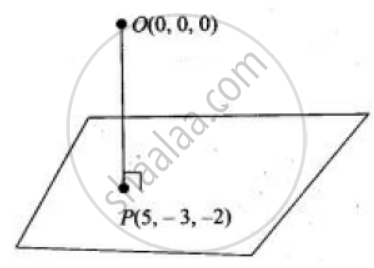Advertisements
Advertisements
Question
If the foot of perpendicular drawn from the origin to a plane is (5, – 3, – 2), then the equation of plane is `vecr.(5hati - 3hatj - 2hatk)` = 38.
Options
True
False
Solution
This statement is True.
Explanation:

From the figure normal to the plane is `vecn = vec(OP) = 5hati - 3hatj - 2hatk`
Plane passing through the point P(5, – 3, – 2).
∴ Equation of the plane is `5(x - 5) - 3(y + 3) - 2(z + 2)` = 0
or `5x - 3y - 2z` = 38
APPEARS IN
RELATED QUESTIONS
Name the octants in which the following points lie:
(1, 2, 3), (4, –2, 3), (4, –2, –5), (4, 2, –5), (–4, 2, –5), (–4, 2, 5),
(–3, –1, 6), (2, –4, –7).
If the origin is the centroid of the triangle PQR with vertices P (2a, 2, 6), Q (–4, 3b, –10) and R (8, 14, 2c), then find the values of a, b and c.
Find the image of:
(–5, 0, 3) in the xz-plane.
Planes are drawn through the points (5, 0, 2) and (3, –2, 5) parallel to the coordinate planes. Find the lengths of the edges of the rectangular parallelepiped so formed.
Find the distances of the point P(–4, 3, 5) from the coordinate axes.
Determine the point on z-axis which is equidistant from the points (1, 5, 7) and (5, 1, –4).
Find the coordinates of the point which is equidistant from the four points O(0, 0, 0), A(2, 0, 0), B(0, 3, 0) and C(0, 0, 8).
Verify the following:
(5, –1, 1), (7, –4,7), (1, –6,10) and (–1, – 3,4) are the vertices of a rhombus.
Find the locus of the point, the sum of whose distances from the points A(4, 0, 0) and B(–4, 0, 0) is equal to 10.
Show that the points A(1, 2, 3), B(–1, –2, –1), C(2, 3, 2) and D(4, 7, 6) are the vertices of a parallelogram ABCD, but not a rectangle.
Find the ratio in which the sphere x2 + y2 + z2 = 504 divides the line joining the points (12, –4, 8) and (27, –9, 18).
Show that the plane ax + by + cz + d = 0 divides the line joining the points (x1, y1, z1) and (x2, y2, z2) in the ratio \[- \frac{a x_1 + b y_1 + c z_1 + d}{a x_2 + b y_2 + c z_2 + d}\]
Write the distance of the point P (2, 3,5) from the xy-plane.
Write the coordinates of the foot of the perpendicular from the point (1, 2, 3) on y-axis.
Find the point on x-axis which is equidistant from the points A (3, 2, 2) and B (5, 5, 4).
The length of the perpendicular drawn from the point P (3, 4, 5) on y-axis is
The length of the perpendicular drawn from the point P(a, b, c) from z-axis is
Find the co-ordinates of the foot of perpendicular drawn from the point A(1, 8, 4) to the line joining the points B(0, –1, 3) and C(2, –3, –1).
A line makes equal angles with co-ordinate axis. Direction cosines of this line are ______.
If a line makes angles α, β, γ with the positive directions of the coordinate axes, then the value of sin2α + sin2β + sin2γ is ______.
If the line drawn from the point (–2, – 1, – 3) meets a plane at right angle at the point (1, – 3, 3), find the equation of the plane
Find the equation of the plane through the points (2, 1, –1) and (–1, 3, 4), and perpendicular to the plane x – 2y + 4z = 10.
The plane ax + by = 0 is rotated about its line of intersection with the plane z = 0 through an angle α. Prove that the equation of the plane in its new position is ax + by `+- (sqrt(a^2 + b^2) tan alpha)z ` = 0
The plane 2x – 3y + 6z – 11 = 0 makes an angle sin–1(α) with x-axis. The value of α is equal to ______.
The direction cosines of the vector `(2hati + 2hatj - hatk)` are ______.
The intercepts made by the plane 2x – 3y + 5z +4 = 0 on the co-ordinate axis are `-2, 4/3, - 4/5`.
